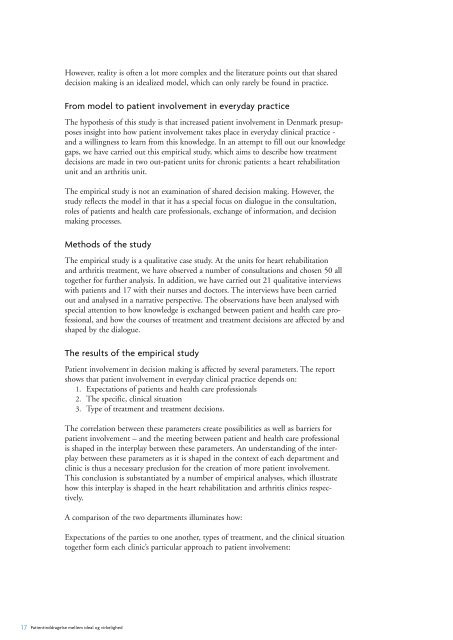Patientinddragelse mellem ideal og virkelighed - Sundhedsstyrelsen
Patientinddragelse mellem ideal og virkelighed - Sundhedsstyrelsen
Patientinddragelse mellem ideal og virkelighed - Sundhedsstyrelsen
Create successful ePaper yourself
Turn your PDF publications into a flip-book with our unique Google optimized e-Paper software.
However, reality is often a lot more complex and the literature points out that shared<br />
decision making is an <strong>ideal</strong>ized model, which can only rarely be found in practice.<br />
From model to patient involvement in everyday practice<br />
The hypothesis of this study is that increased patient involvement in Denmark presupposes<br />
insight into how patient involvement takes place in everyday clinical practice -<br />
and a willingness to learn from this knowledge. In an attempt to fill out our knowledge<br />
gaps, we have carried out this empirical study, which aims to describe how treatment<br />
decisions are made in two out-patient units for chronic patients: a heart rehabilitation<br />
unit and an arthritis unit.<br />
The empirical study is not an examination of shared decision making. However, the<br />
study reflects the model in that it has a special focus on dial<strong>og</strong>ue in the consultation,<br />
roles of patients and health care professionals, exchange of information, and decision<br />
making processes.<br />
methods of the study<br />
The empirical study is a qualitative case study. At the units for heart rehabilitation<br />
and arthritis treatment, we have observed a number of consultations and chosen 50 all<br />
t<strong>og</strong>ether for further analysis. In addition, we have carried out 21 qualitative interviews<br />
with patients and 17 with their nurses and doctors. The interviews have been carried<br />
out and analysed in a narrative perspective. The observations have been analysed with<br />
special attention to how knowledge is exchanged between patient and health care professional,<br />
and how the courses of treatment and treatment decisions are affected by and<br />
shaped by the dial<strong>og</strong>ue.<br />
the results of the empirical study<br />
Patient involvement in decision making is affected by several parameters. The report<br />
shows that patient involvement in everyday clinical practice depends on:<br />
1. Expectations of patients and health care professionals<br />
2. The specific, clinical situation<br />
3. Type of treatment and treatment decisions.<br />
The correlation between these parameters create possibilities as well as barriers for<br />
patient involvement – and the meeting between patient and health care professional<br />
is shaped in the interplay between these parameters. An understanding of the interplay<br />
between these parameters as it is shaped in the context of each department and<br />
clinic is thus a necessary preclusion for the creation of more patient involvement.<br />
This conclusion is substantiated by a number of empirical analyses, which illustrate<br />
how this interplay is shaped in the heart rehabilitation and arthritis clinics respectively.<br />
A comparison of the two departments illuminates how:<br />
Expectations of the parties to one another, types of treatment, and the clinical situation<br />
t<strong>og</strong>ether form each clinic’s particular approach to patient involvement:<br />
17 <strong>Patientinddragelse</strong> <strong>mellem</strong> <strong>ideal</strong> <strong>og</strong> <strong>virkelighed</strong>

















